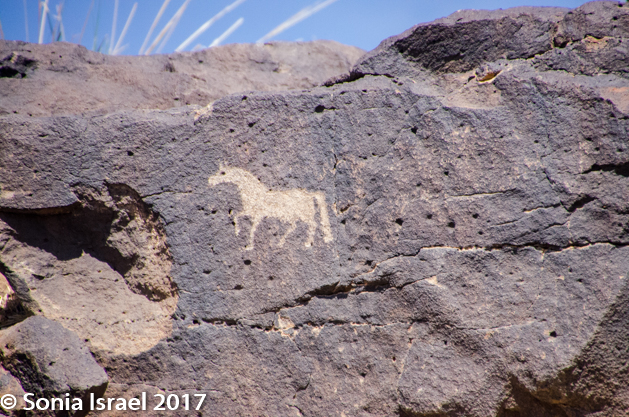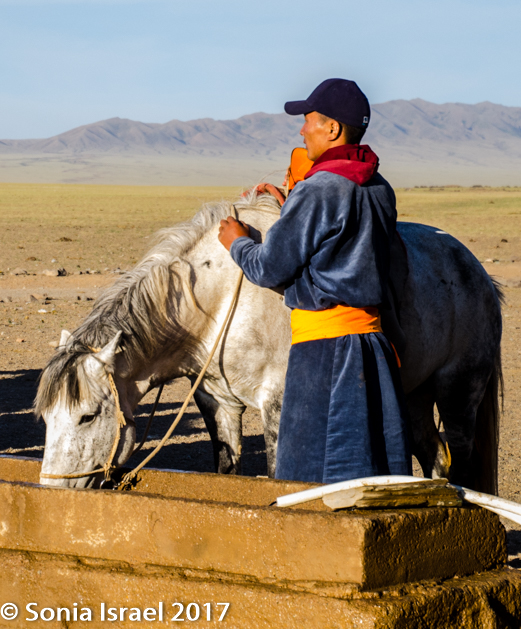National Geographic Trip to Mongolia, Day 6, June 16, 2017
Petroglyphs and Rabbits
After a great night’s sleep in our ger, and a great morning shower, we headed over to the dining hall ger for breakfast. The sun was shining. The air was warm. And there was beauty everywhere we looked.
Breakfast
For breakfast, there were fresh eggs of our choice, fabulous homemade bread, gambir (a Mongolian pancake made from basic dough), cheese, oatmeal, jams, fruit and wonderful coffee. There would no losing weight here.
The Local Petroglyphs
After breakfast most of the group drove to Havtsgait Valley, site of ancient petroglyphs (rock drawings) left by early Gobi settlers. But we were told it could be a rough hike so Andy and I and Kathlyn and Dick along with a few others stayed behind. But we were not bored nor were we left to our own devices. One of the young men working here, who grew up here, took us on our own hike to see the petroglyphs right on the grounds of the Three Camels. These rock inscriptions date back to the Mongolian Hunnu State which reigned from 3000 BCE and 2 AD. These ancient people practiced a form of nomadic pastoralism that closely resembles the lifestyle of contemporary herders. Some of the etchings looked quite new, more like graffiti. But some were clearly old and resembled the Argali sheep, camels and horses. We stood there, the sun beaming down on us, the valley at our backs and just imaged being a nomad thousands of years ago carving your story onto a rock. Did they ever wonder if there would be anyone to see it in the future? Do we ever wonder if our accomplishments will be seen in our future? We can only hope that these great antiquities continue to survive.
The Rabbit
We walked back down the mountain to our valley. It was hot. Scorching hot. The ground was yellow. And the tracks stretched endlessly. Lizards were scurrying everywhere. And then there was this rabbit. At first he was just jumping between the rocks. And then he headed towards the gers. And while we watched, he explored the area where the felt met the ground, found an opening just big enough, and jumped into the ger! Luckily it wasn’t ours! I guess it felt cooler in there for him too.
Burial Mounds
In addition to the petroglyphs, there were also some burial mounds near the lodge, but these were burial mounds but only horse skulls and bones were found there. The horse if the most treasured possession here. Horses are currency. Horses are survival. So it was no surprise that there would be a horse cemetery.
How to Build a Ger
And then we noticed that the staff were putting up a ger as a demonstration. So we got to watch how the nomads do it, over and over again as they move from one grazing spot to another. As described in my previous blog (see Mongolia Day 2) , they start with the lattice work being stretched around until the ends meet. Then the slats are attached, reaching up and attaching to the crown. Then the felt is draped over the whole thing. I make it sound simple. And to the nomads it is, with everyone in the family participating in building and rebuilding their home.
The Nomads
We walked back over to the watering hole as the animals and the herders were back. There was one young man in his deel leading his horse to water. Watching him was almost surreal as most of the herders wore blue jeans and t-shirts with some American slogan on it. But he was in his traditional, indigenous clothes (although with a baseball cap). Maybe because the festival was beginning later that day. Maybe just because that’s how he liked to dress. I don’t know. But it is the way I had imagined that all the Mongolian men would be dressed. And so I watched him. I photographed him. And I just enjoyed the view of the man with his horse and the desert behind them. And then he headed off with all his horses.
There was also a big truck there, yet another way that the horses are herded and brought from place to place these days. The family had four young children and they all crowded into the cab of the truck and smiled at us. The oldest one was sucking on a lollipop, so in his photograph, although it looks like he is smoking, it is just the lollipop stick. In fact, I did not see one Mongolian in the desert smoking.
It was time for lunch – pizza and Russian borsch, and then one of the highlights of the trip, the reason we came at this particular time of year. The Nadam festival.













































